Special Report
The Most Popular National Park in Every State
Published:
Last Updated:
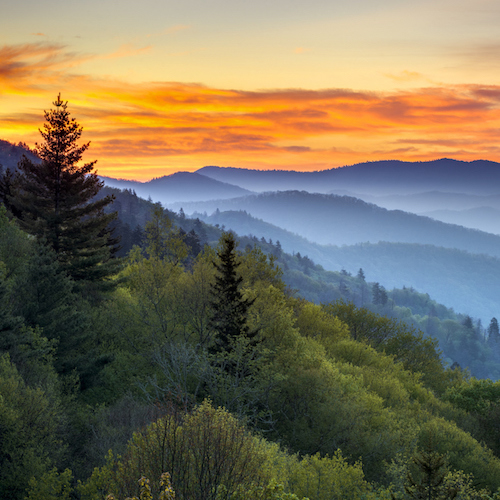
A variety of reasons could explain this significant increase of tourism to national parks. An improving economy has put more money in people’s pockets and allowed them to travel to parks. Sharing pictures and videos on social platforms could be motivating people to visit the great outdoors. The trend of healthy living and environmentalism may be influencing tourists to explore.
24/7 Wall St. reviewed National Park Service visitor data at all national parks, historical parks, recreational areas, national preserves, national memorials, and national monuments in the country to determine how many tourists they had in 2016. While some states have many national parks, others have just one.
Visits and support of conservation have grown exponentially over the years. In his eight years in office, President Barack Obama placed 548 million acres of habitat under protection and created 22 new national parks. The only other president who has outdone the 21st-century conservation effort is the founder of U.S. National Parks himself, President Theodore Roosevelt.
As president, Roosevelt protected around 290 million acres of public land and signed into law the 1906 American Antiquities Act. This action was followed by the passage of the Organic Act in 1916, which created the National Park Service.
While Americans generally approve of preserving their land, the formation of national parks and monuments has stirred controversy in the past — sometimes pitting conservationists against ranchers and developers.
Which park do you think is the most visited in your state?
Click here to see the most popular national park in each state
Click here to see our methodology
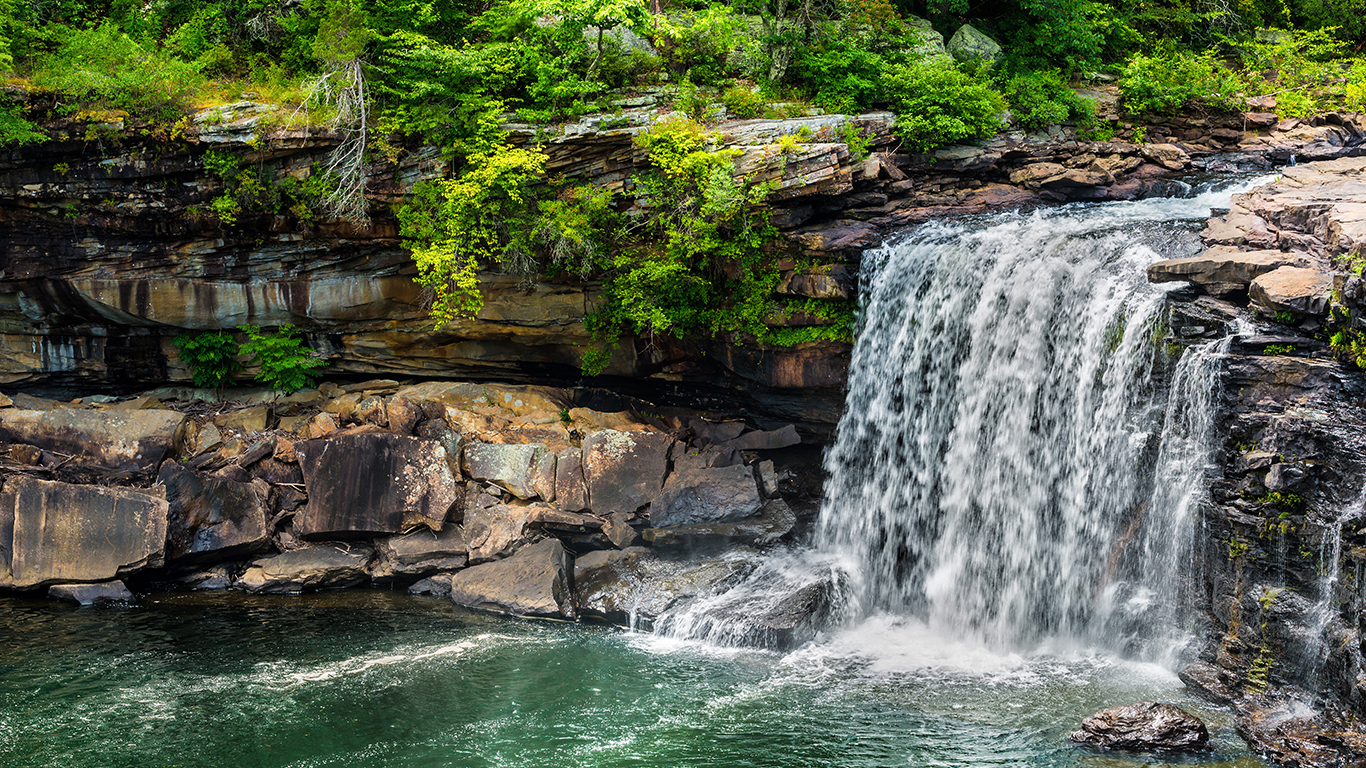
1. Alabama
> Park: Little River Canyon National Preserve
> 2016 visits: 462,700
> 5-year change in visits: +1.1%
> 2016 visitor spending (in thousands): $27,053.40
Little River Canyon National Preserve was created in 1992 to protect the landscapes of the Little River Canyon. Of the 15,288 acres of the preserve, 11,042 acres are federally owned and managed. The preserve shields the Little River Canyon, the Little River, and a variety of rare and threatened plant and animal species.
[in-text-ad]
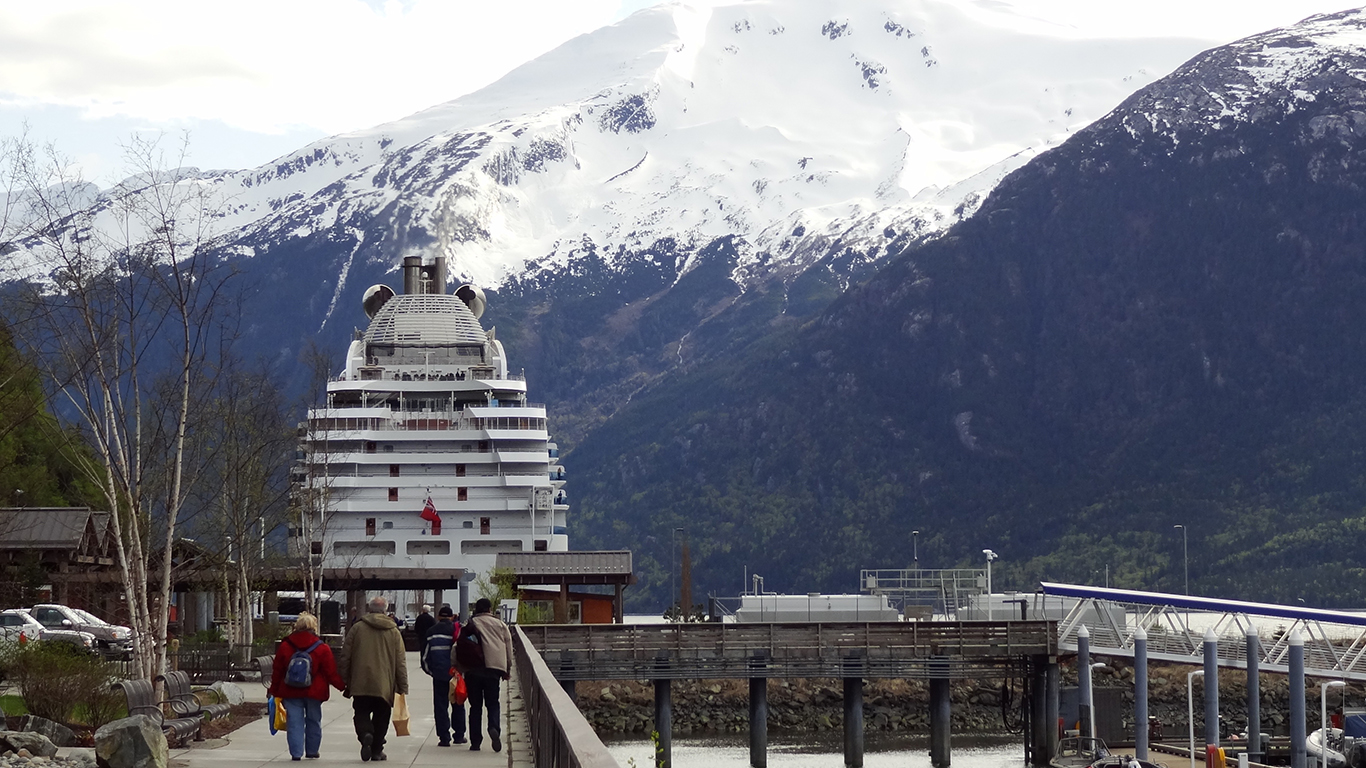
2. Alaska
> Park: Klondike Gold Rush National Historical Park
> 2016 visits: 912,351
> 5-year change in visits: +0.1%
> 2016 visitor spending (in thousands): $166,412.40
To understand the significance of this park is to understand its history. In the summer of 1896, gold was discovered in the remote north of Yukon, Canada. The discovery triggered a migration north that became known as the Klondike Gold Rush. To reach Yukon, migrants traveled through Alaska, taking either the Chilkoot Trail or the White Pass trail. Today, visitors can travel the same path. The park also includes the historic gold rush boom town of Skagway with its restored buildings such as saloons, shops, and railway depot.

3. Arizona
> Park: Grand Canyon National Park
> 2016 visits: 5,969,811
> 5-year change in visits: +0.4%
> 2016 visitor spending (in thousands): $648,170.90
The Grand Canyon, which became a national park in 1919, is one of the most visited and photographed parks in the nation. This geologic wonder, cleaved by the Colorado River, is 277 miles long, drops as much as 6,000 feet, and is 18 miles across at its widest point.
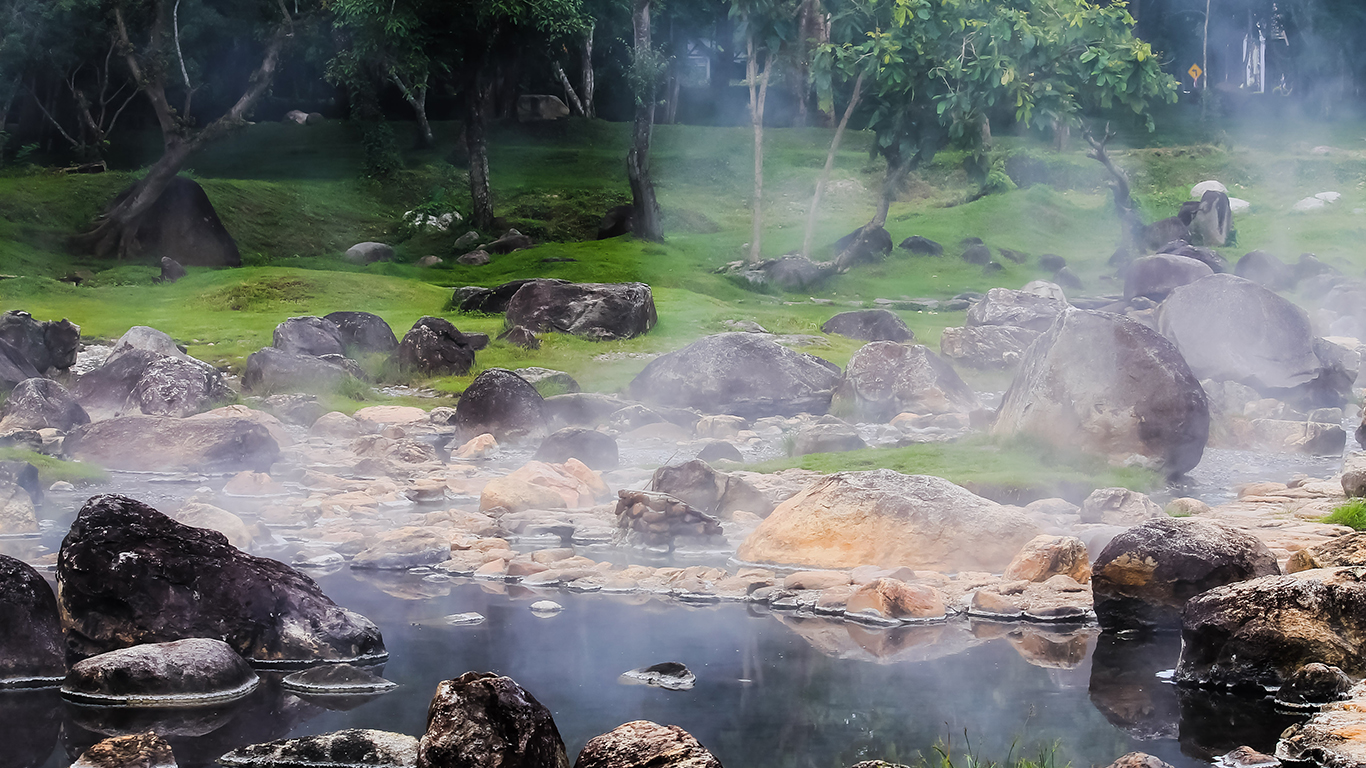
4. Arkansas
> Park: Hot Springs National Park
> 2016 visits: 1,544,300
> 5-year change in visits: +0.1%
> 2016 visitor spending (in thousands): $98,960.20
Hot Springs became part of the United States as part of the Louisiana Purchase in 1803. Congress declared the area a protected reservation in 1832, and it became a national park in 1921. Native Americans and early European explorers have ventured to this area to bathe in the soothing waters of the springs and its thermal pools. Among the points of interest is Bathhouse Row, a collection of bathhouse buildings constructed between 1892 and 1923.
[in-text-ad-2]

5. California
> Park: Yosemite National Park
> 2016 visits: 5,028,868
> 5-year change in visits: +0.3%
> 2016 visitor spending (in thousands): $520,629.10
Yosemite National Park was first protected in 1864 and was established as a national park in 1890. The park, which spans nearly than 748,000 acres, is about the size of Rhode Island. Yosemite is known for the largest waterfall in North America, rock formations such as El Capitan, and Giant Sequoia trees estimated to be more than 3,000 years old.
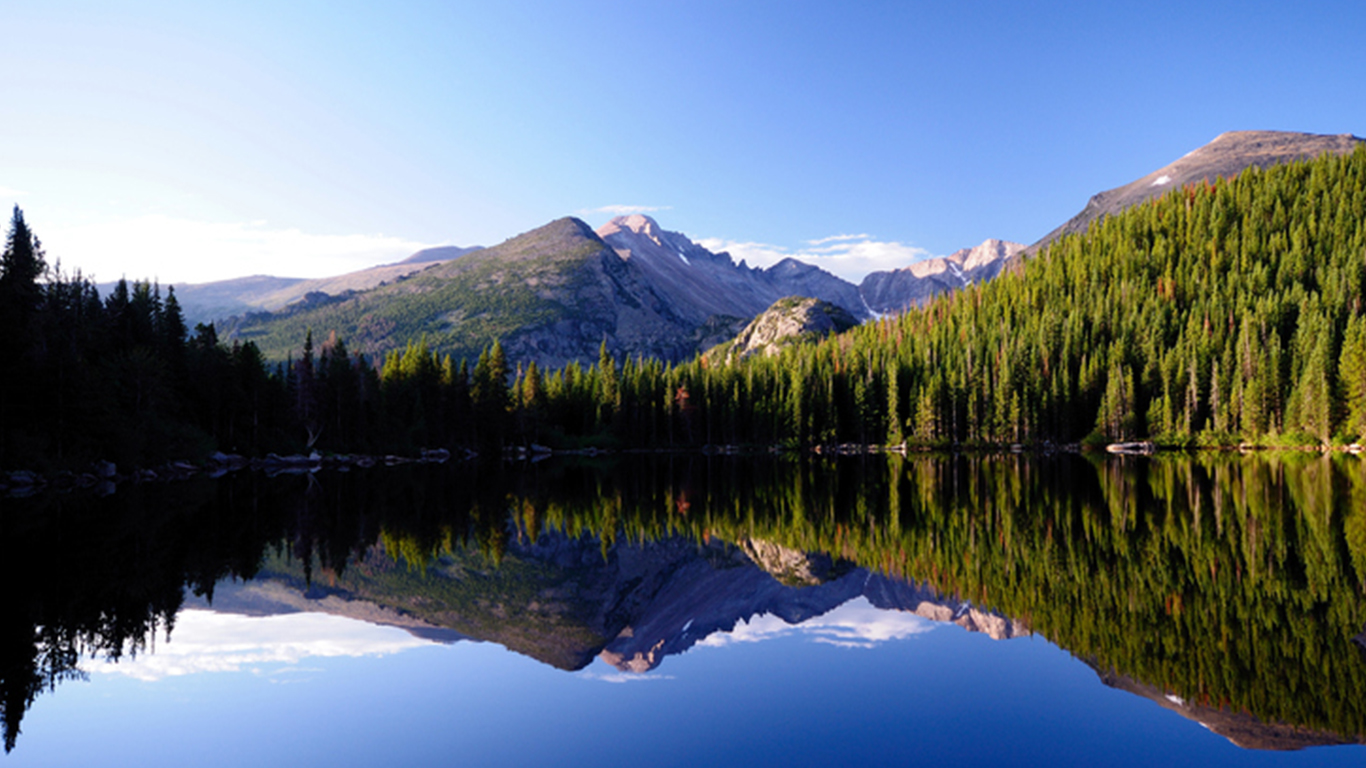
6. Colorado
> Park: Rocky Mountain National Park
> 2016 visits: 4,517,585
> 5-year change in visits: +0.4%
> 2016 visitor spending (in thousands): $298,746.70
High mountain lakes and evergreen forests line the landscape of Rocky Mountain National Park, the highest in the country. Visitors can observe animals while hiking on over 300 miles of trail that can get as high as 12,000 feet above sea level.
[in-text-ad]

7. Connecticut
> Park: Weir Farm National Historic Site
> 2016 visits: 39,079
> 5-year change in visits: +0.7%
> 2016 visitor spending (in thousands): $2,285.00
Weir Farm National Historic Site was designed and preserved by artists. It is the only park dedicated to American painting. Painter Julian Alden Weir, born into a family of artists, took possession of the farm in 1882 in an exchange for one of his paintings and $10.
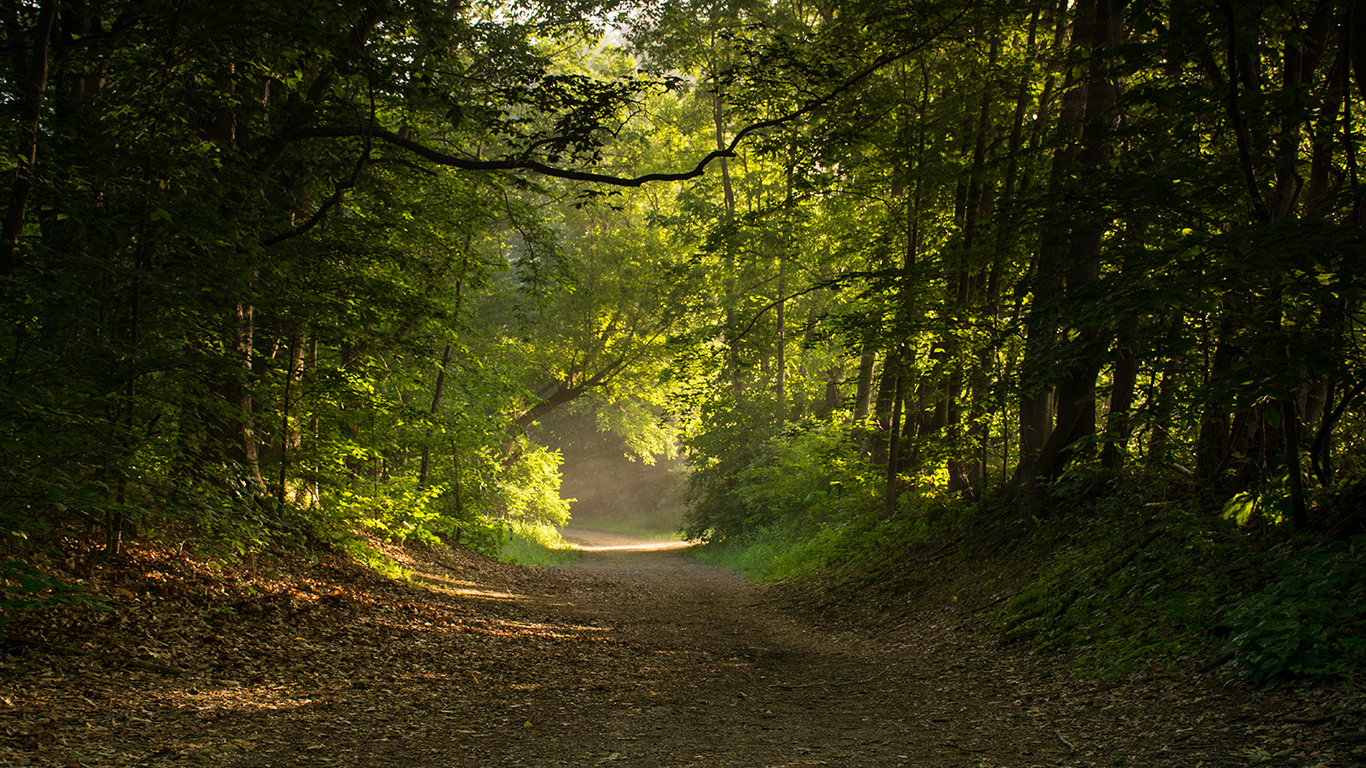
8. Delaware
> Park: First State National Historical Park
> 2016 visits: N/A
> 5-year change in visits: N/A
> 2016 visitor spending (in thousands): N/A
First State National Historical Park is the newest national park on this list. It also is Delaware’s first national park. Designated in 2015, First State commemorates Delaware as the first state to ratify the United States Constitution. Considering how the park has only recently opened, it has yet to report visitor-related data. However, Superintendent Ethan McKinley estimates First State had 100,000 visitors in 2016.

9. Florida
> Park: Everglades National Park
> 2016 visits: 930,907
> 5-year change in visits: 0.0%
> 2016 visitor spending (in thousands): $91,321.40
Everglades National Park is the largest subtropical wilderness area in the United States. After being hit hard by Hurricane Irma, the park has only recently reopened to visitors. Where else can you find a World Heritage Site, International Biosphere Reserve, and a Wetland of International Importance, or rare and endangered species such as the manatee, American crocodile,and the Florida panther?
[in-text-ad-2]

10. Georgia
> Park: Chattahoochee River National Recreation Area
> 2016 visits: 2,736,385
> 5-year change in visits: -0.1%
> 2016 visitor spending (in thousands): $119,071.90
The Chattahoochee River is a National Recreation Area. The river originates in the Blue RIdge Mountains of northern Georgia, flows in a southwesterly direction, and empties into the Gulf of Mexico. It is a recreational resource, transportation route, and a key engine for commerce.

11. Hawaii
> Park: Hawaii Volcanoes National Park
> 2016 visits: 1,887,580
> 5-year change in visits: +0.4%
> 2016 visitor spending (in thousands): $159,195.50
Hawaii Volcanoes National Park is home to two of the world’s most active volcanoes, Kīlauea and Mauna Loa, which are still adding landmass to Hawaii. The park was created to preserve the natural setting of the two volcanoes. It is also serves to protect the area’s various flora and fauna.
[in-text-ad]
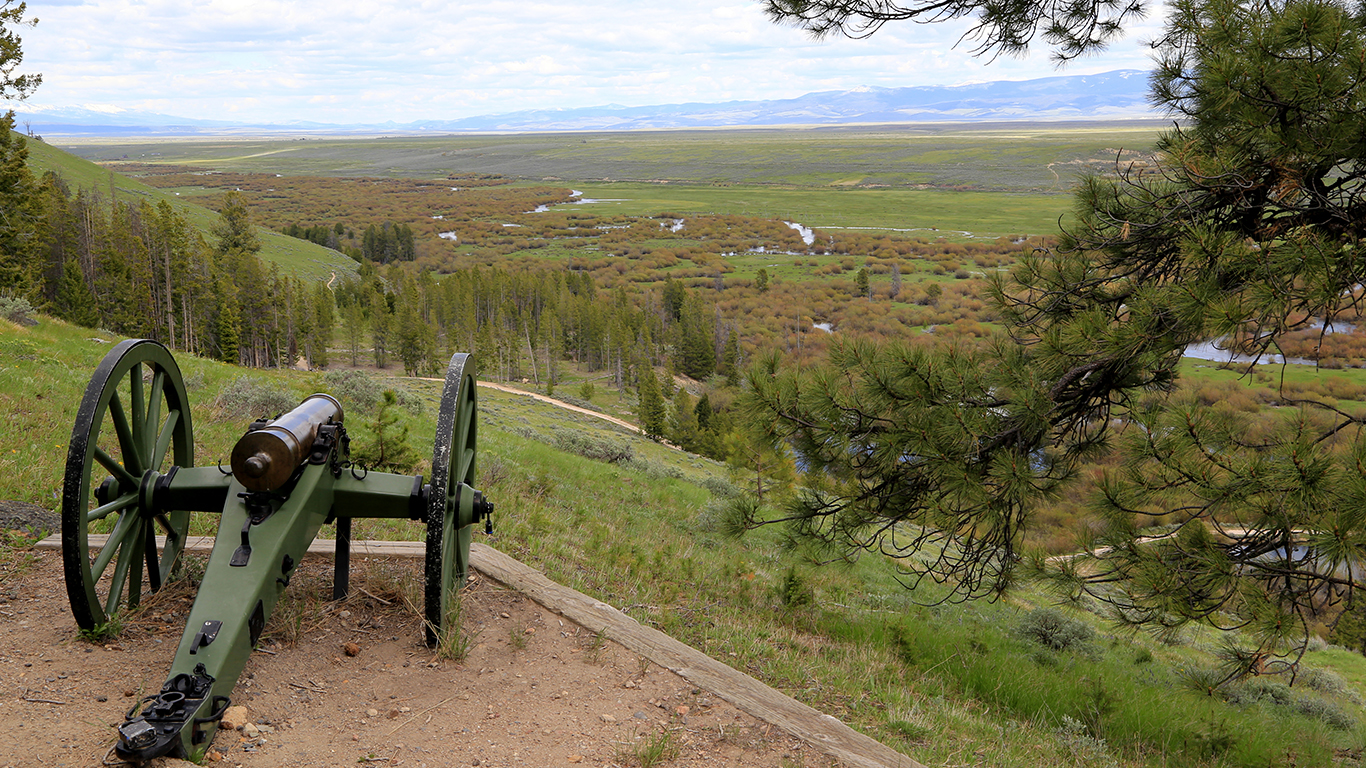
12. Idaho
> Park: Nez Perce National Historical Park
> 2016 visits: 239,908
> 5-year change in visits: -0.2%
> 2016 visitor spending (in thousands): $14,027.00
The Nez Perce National Historical Park commemorates the Nez Perce people, who have been associated with the Idaho landscape for generations. The park is home to the Bear Paw Battlefield that immortalizes the last battle of the Nez Perce War between the Nez Perce and the U.S. Army in 1877.

13. Illinois
> Park: Lincoln Home National Historic Site
> 2016 visits: 239,719
> 5-year change in visits: -0.2%
> 2016 visitor spending (in thousands): $14,563.10
Abraham Lincoln’s Springfield home, built in 1839, was opened to the public in 1887. Lincoln and his family lived in the 12-room, Greek Revival style house for 17 years before he became president. The house sheds a different, more personal light, on Lincoln’s life before he became the 16th president. Among the attractions at the house are the toys the Lincoln children played with as well as Mary Lincoln’s recipe for white cake.
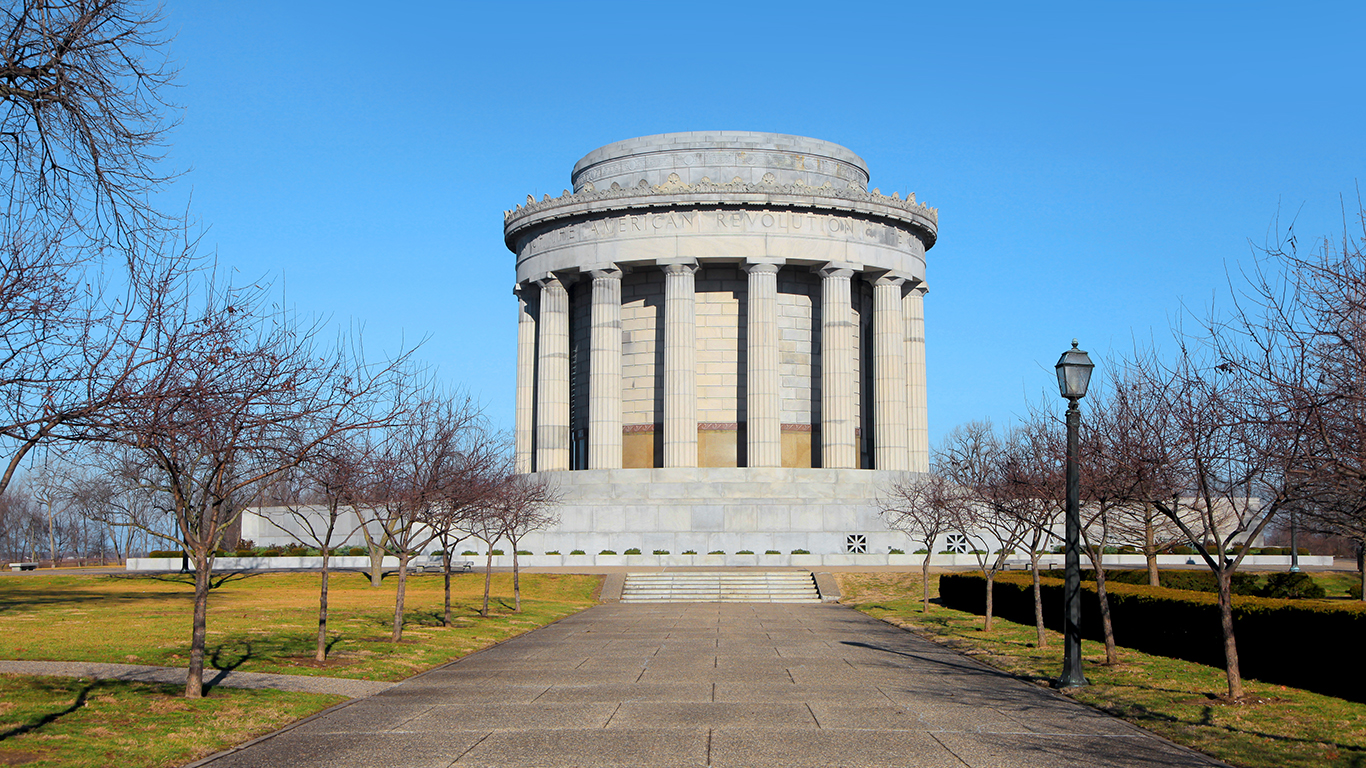
14. Indiana
> Park: George Rogers Clark National Historical Park
> 2016 visits: 126,095
> 5-year change in visits: -0.1%
> 2016 visitor spending (in thousands): $7,372.60
On February 25, 1779, George Rogers Clark led a raid against the British on Fort Sackville. That raid became a turning point in the American Revolution. While the exact location of the fort is unknown, the park is a symbolic memorial to one of the most important victories of the war.
[in-text-ad-2]
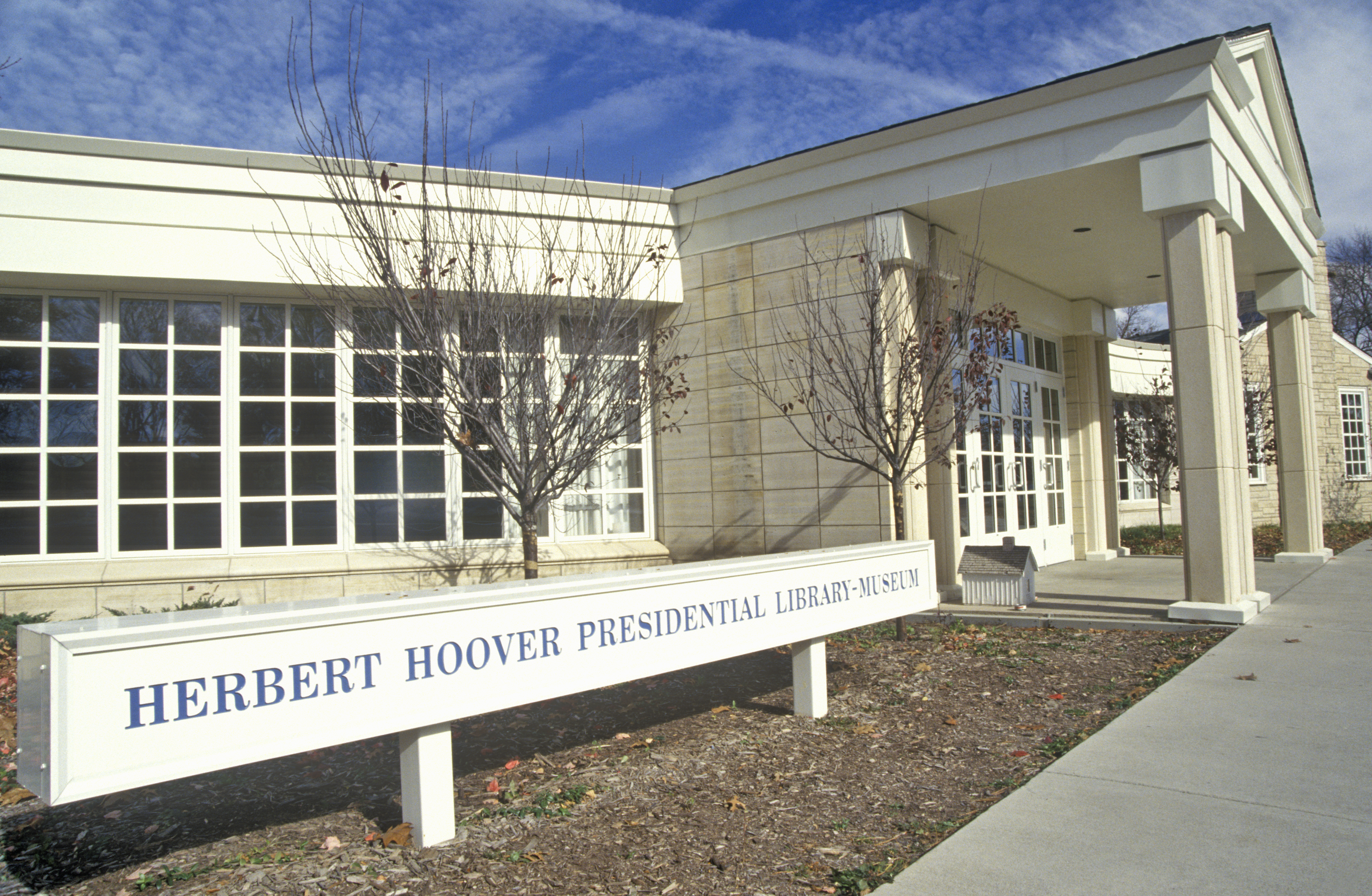
15. Iowa
> Park: Herbert Hoover National Historic Site
> 2016 visits: 152,382
> 5-year change in visits: +0.1%
> 2016 visitor spending (in thousands): $8,909.70
The simple two-room cottage in West Branch where Herbert Hoover was born is a National Historic Site. Hoover, the nation’s 31st president, was born to a Quaker family and orphaned at age 9. He would go on to lead relief efforts in Europe after World War I and become the 31st president of the United States.

16. Kansas
> Park: Fort Larned National Historic Site
> 2016 visits: 31,060
> 5-year change in visits: +0.2%
> 2016 visitor spending (in thousands): $1,882.30
This historic site preserves Fort Larned, a U.S. Army outpost created in 1859 to guard traffic along the Santa Fe Trail, a vital commercial and cultural route that connected the Great Plains to the rest of North America.
[in-text-ad]
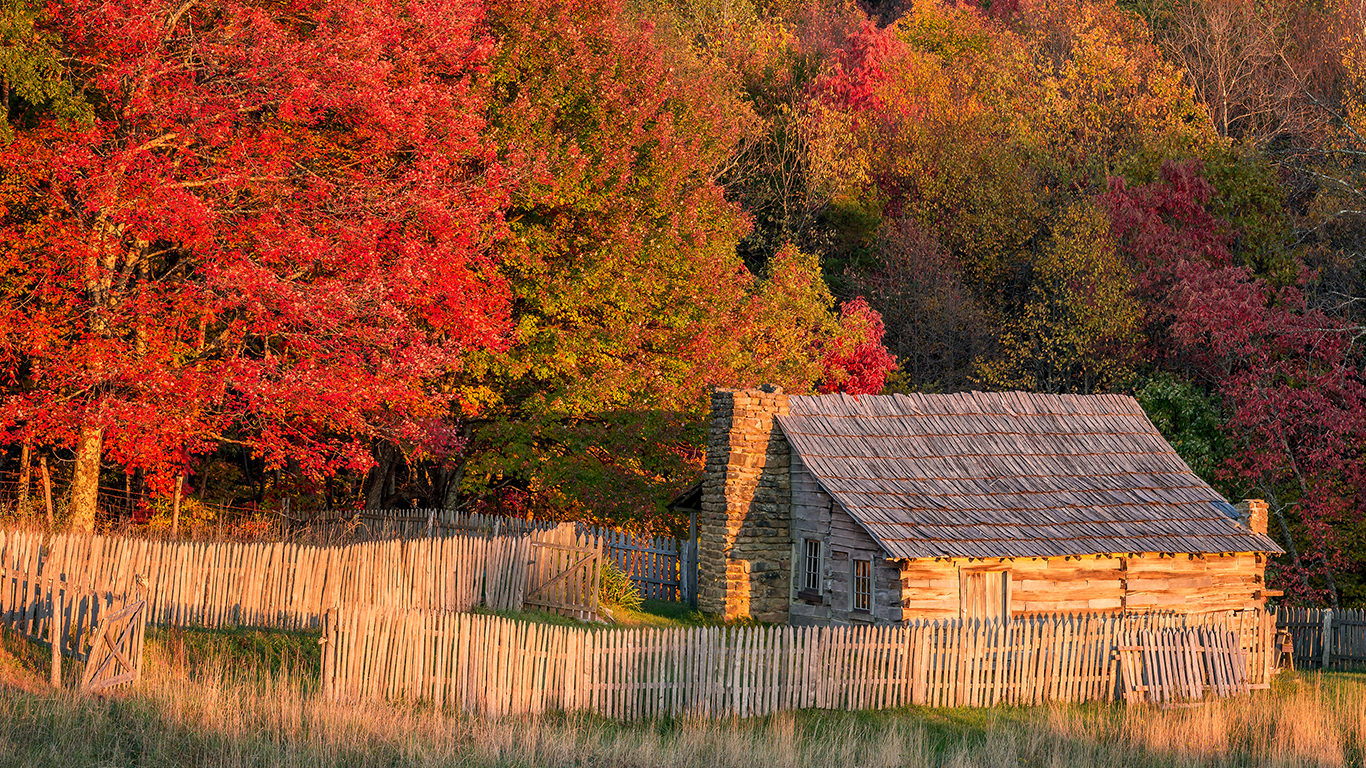
17. Kentucky
> Park: Cumberland Gap National Historical Park
> 2016 visits: 762,959
> 5-year change in visits: -0.1%
> 2016 visitor spending (in thousands): $52,528.80
The Cumberland Gap, which became a national historical park in 1940, is one of the three natural breaks in the Appalachian Mountains. It served as a gateway for Native Americans who used it as a footpath. The Cumberland Gap was also a passage west for American settlers, including Abraham Lincoln’s parents and grandparents.

18. Louisiana
> Park: Jean Lafitte National Historical Park and Preserve
> 2016 visits: 438,420
> 5-year change in visits: 0.0%
> 2016 visitor spending (in thousands): $25,633.80
Louisiana’s most visited national historical park and preserve is named after Jean Lafitte, a French privateer and smuggler who defended New Orleans in the War of 1812. Located on the Mississippi River delta, the park also features a cultural center paying homage to the Acadians, exiles from Canada who came to Louisiana and became Cajuns.

19. Maine
> Park: Acadia National Park
> 2016 visits: 3,303,393
> 5-year change in visits: +0.4%
> 2016 visitor spending (in thousands): $274,208.80
Acadia National Park, which spans more than 47,000 acres, was established in 1916 and was the first national park established east of the Mississippi River. The park’s carriage roads and stone bridges were financed by philanthropist John D. Rockefeller Jr. The 27-mile Park Loop Road is one of America’s most spectacular coastline drives.
[in-text-ad-2]

20. Maryland
> Park: Chesapeake & Ohio Canal National Historical Park
> 2016 visits: 3,657,939
> 5-year change in visits: -0.1%
> 2016 visitor spending (in thousands): $91,239.40
Known as a passage to the West, the Chesapeake & Ohio Canal was used as one of America’s earliest forms of transportation for nearly 100 years. The canal runs along the Potomac River, the dividing line between the Union and Confederacy during the Civil War. Today, the park tells the historical significance of the canal.

21. Massachusetts
> Park: Boston National Historical Park
> 2016 visits: 2,594,495
> 5-year change in visits: 0.0%
> 2016 visitor spending (in thousands): $151,696.40
Few places stir patriotic pride as much as Boston. The 43 acres devoted to Boston National Historical Park represent some of the most special places in American history — Old North Church, USS Constitution, site of the Boston Tea Party, and Bunker Hill Monument.
[in-text-ad]

22. Michigan
> Park: Isle Royale National Park
> 2016 visits: 24,966
> 5-year change in visits: +0.6%
> 2016 visitor spending (in thousands): $5,600.70
A lonely island surrounded by Lake Superior, Isle Royale is paradise for aquatics enthusiasts. Isle Royale, established as a national park in 1940, provides scenic views for backpackers, hikers, boaters, and scuba divers right underneath Michigan’s border with Canada.

23. Minnesota
> Park: Voyageurs National Park
> 2016 visits: 241,912
> 5-year change in visits: +0.4%
> 2016 visitor spending (in thousands): $19,780.20
Voyageurs National Park is a boater’s nirvana, as you might expect from the state that claims to have 10,000 lakes. The park spans 44 square miles of navigable waters for boating, kayaking, and canoeing. Voyageurs sits on the U.S.-Canadian border and is the only national park in Minnesota.

24. Mississippi
> Park: Natchez National Historical Park
> 2016 visits: 204,120
> 5-year change in visits: 0.0%
> 2016 visitor spending (in thousands): $11,934.60
The small town of Natchez, Mississippi is home to its own national historical park. The park was created to protect the sites of peoples of Natchez and its surrounding area, from its earliest inhabitants to people in the modern era. The name “Natchez” is the name of the Native American people who inhabited the area
[in-text-ad-2]
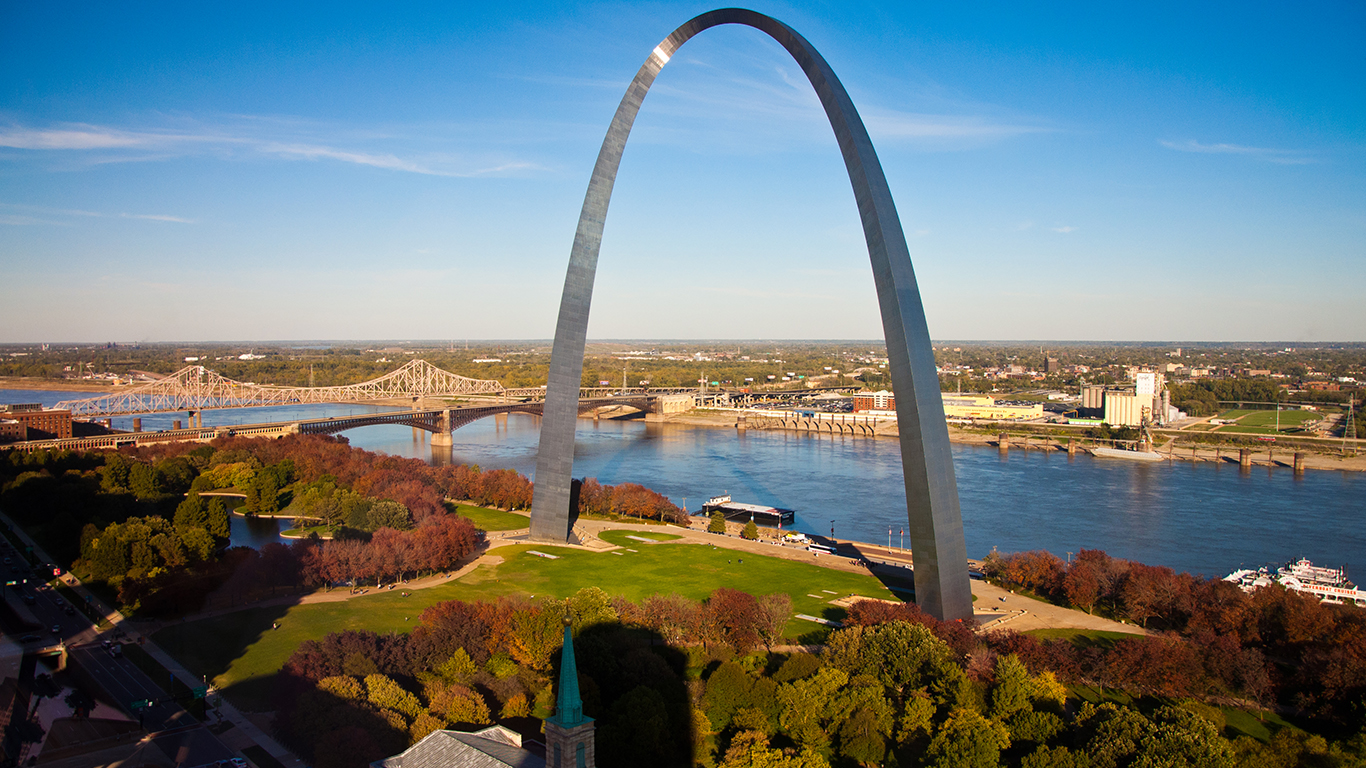
25. Missouri
> Park: Jefferson National Expansion Memorial
> 2016 visits: 1,271,855
> 5-year change in visits: -0.4%
> 2016 visitor spending (in thousands): $127,061.70
The Jefferson National Expansion Memorial in St. Louis is a national park famous for its 630-foot arch designed by renowned architect Eero Saarinen that symbolizes the pathway to the west. The park was created to commemorate Thomas Jefferson’s role in opening the West, to the pioneers who helped define its history, and to Dred Scott, the escaped slave who sued for his freedom in the city’s courthouse.

26. Montana
> Park: Glacier National Park
> 2016 visits: 2,946,681
> 5-year change in visits: +0.6%
> 2016 visitor spending (in thousands): $250,815.50
Shared between Canada and the United States, Glacier National Park protects 7,000-year-old glaciers and their surrounding environment, including wetlands, lakes, mountains, rivers, fossils, flora, fauna, and more. Some of the best-known fossils are found on the east side of the park in the Altyn Formation, which is composed of nearly 1.5 billion-year-old limestone and dolomite.
[in-text-ad]

27. Nebraska
> Park: Scotts Bluff National Monument
> 2016 visits: 130,085
> 5-year change in visits: 0.0%
> 2016 visitor spending (in thousands): $7,605.80
Scotts Bluff National Monument rises 800 feet above the North Platte River in Nebraska and has been a landmark for Native Americans and migrants to the West Coast. The Pony Express National Historic Trail goes through Scotts Bluff. The 3,000-acre region, which became a national monument in 1919, is a mecca for geologists and paleontologists.
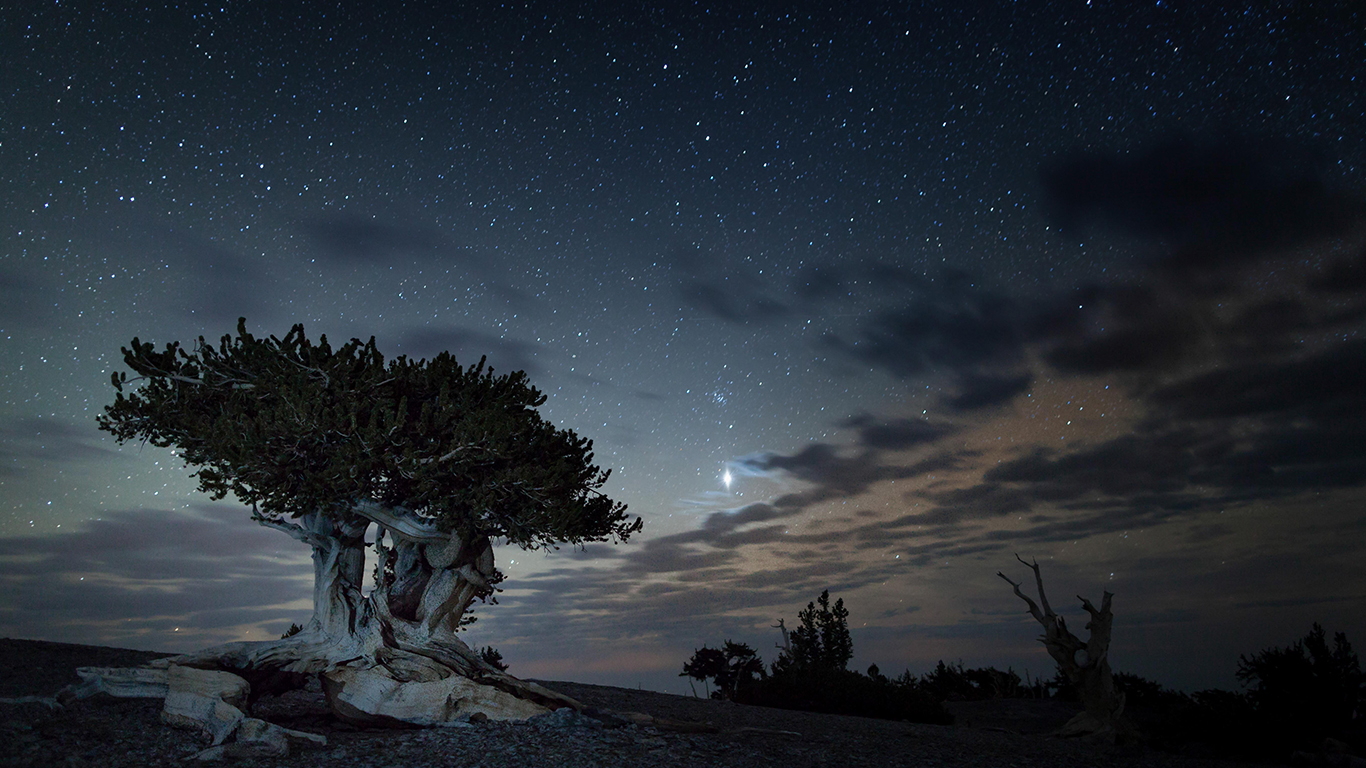
28. Nevada
> Park: Great Basin National Park
> 2016 visits: 144,846
> 5-year change in visits: +0.6%
> 2016 visitor spending (in thousands): $8,362.40
Located 4.5 hours from the flashing lights of Las Vegas is Great Basin National Park. The park is so removed from light that it was officially designated an International Dark Sky Park for its star-gazing qualities. On a clear night sky, thousands of stars, five planets, and other galaxies are visible with the naked eye in Great Basin. Great Basin National Park also is known for its landforms.

29. New Hampshire
> Park: Saint-Gaudens National Historical Site
> 2016 visits: 42,377
> 5-year change in visits: +0.3%
> 2016 visitor spending (in thousands): $2,116.60
The Saint-Gaudens National Historic Site preserves the studios and gardens of Augustus Saint-Gaudens, one of America’s greatest sculptors. Among the works Saint-Gaudens is known for is the sculptor’s stirring vision in bronze of Union Army Col. Robert Gould Shaw leading freed African-American soldiers to fight the Confederacy.
[in-text-ad-2]

30. New Jersey
> Park: Morristown National Historical Park
> 2016 visits: 252,514
> 5-year change in visits: +0.1%
> 2016 visitor spending (in thousands): $14,764.20
The Morristown National Historical Park contains four separate areas of historical significance, including the Ford Mansion, where General George Washington spent the winter of 1779-1780. The mansion is one of the earliest house museums in the United States and became part of the National Park Service in 1933.
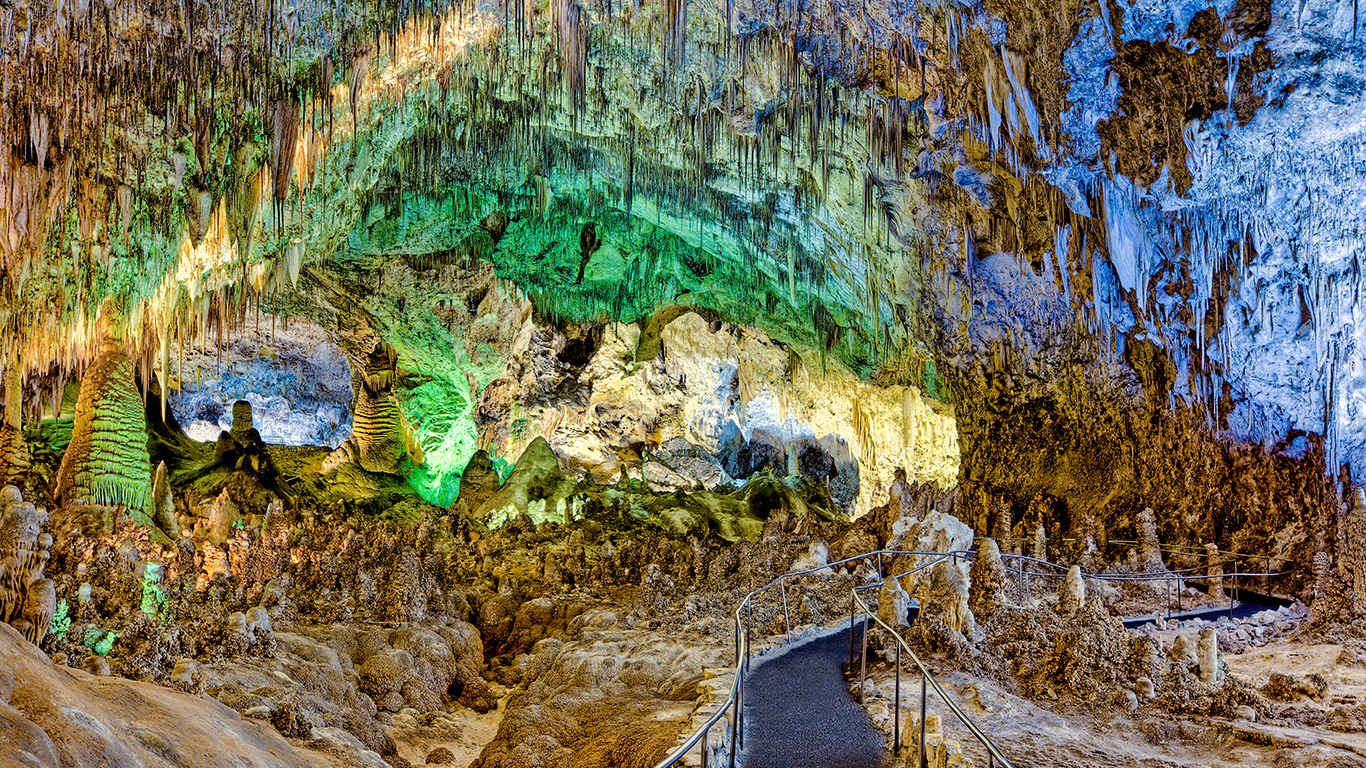
31. New Mexico
> Park: Carlsbad Caverns National Park
> 2016 visits: 466,773
> 5-year change in visits: +0.3%
> 2016 visitor spending (in thousands): $30,064.00
In the desert of New Mexico lies Carlsbad Caverns National Park. There are more than 100 known caves in the park. Carlsbad Cavern, the park’s most popular attraction and its namesake, was formed between 4 million and 6 million years ago.
[in-text-ad]
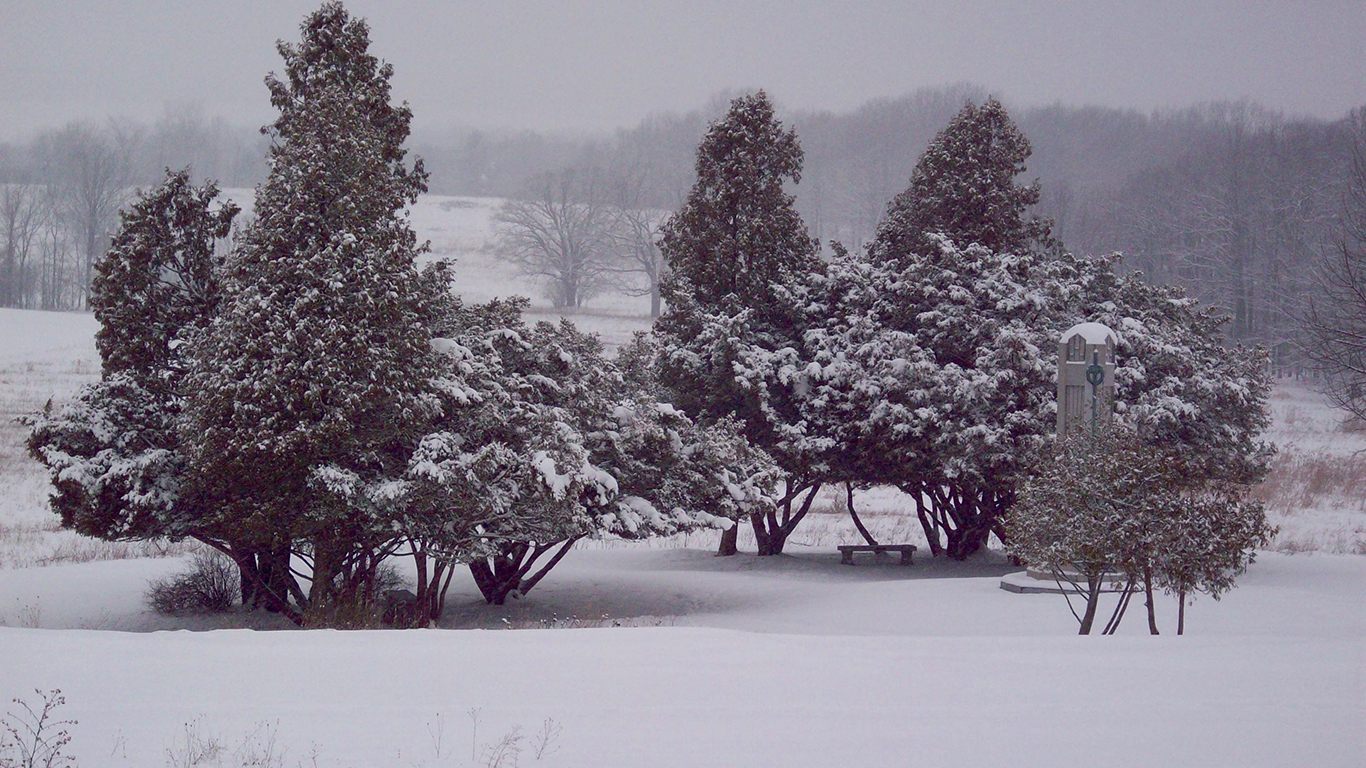
32. New York
> Park: Saratoga National Historical Park
> 2016 visits: 102,808
> 5-year change in visits: +0.6%
> 2016 visitor spending (in thousands): $6,011.00
Saratoga National Historical Park preserves the memory of the American Colonial victory over the British in 1777. It was coined the “turning point of the American revolution” because it led to international recognition for the emerging American nation, as well as support from France and other countries.

33. North Carolina
> Park: Great Smoky Mountains National Park
> 2016 visits: 11,312,786
> 5-year change in visits: +0.3%
> 2016 visitor spending (in thousands): $942,731.80
Great Smoky Mountains National Park is a UNESCO world heritage site located in the heart of North Carolina’s Great Smoky and Blue Ridge mountain ranges shared with Tennessee. As of 2016, Great Smoky was the most visited national park in the United States.
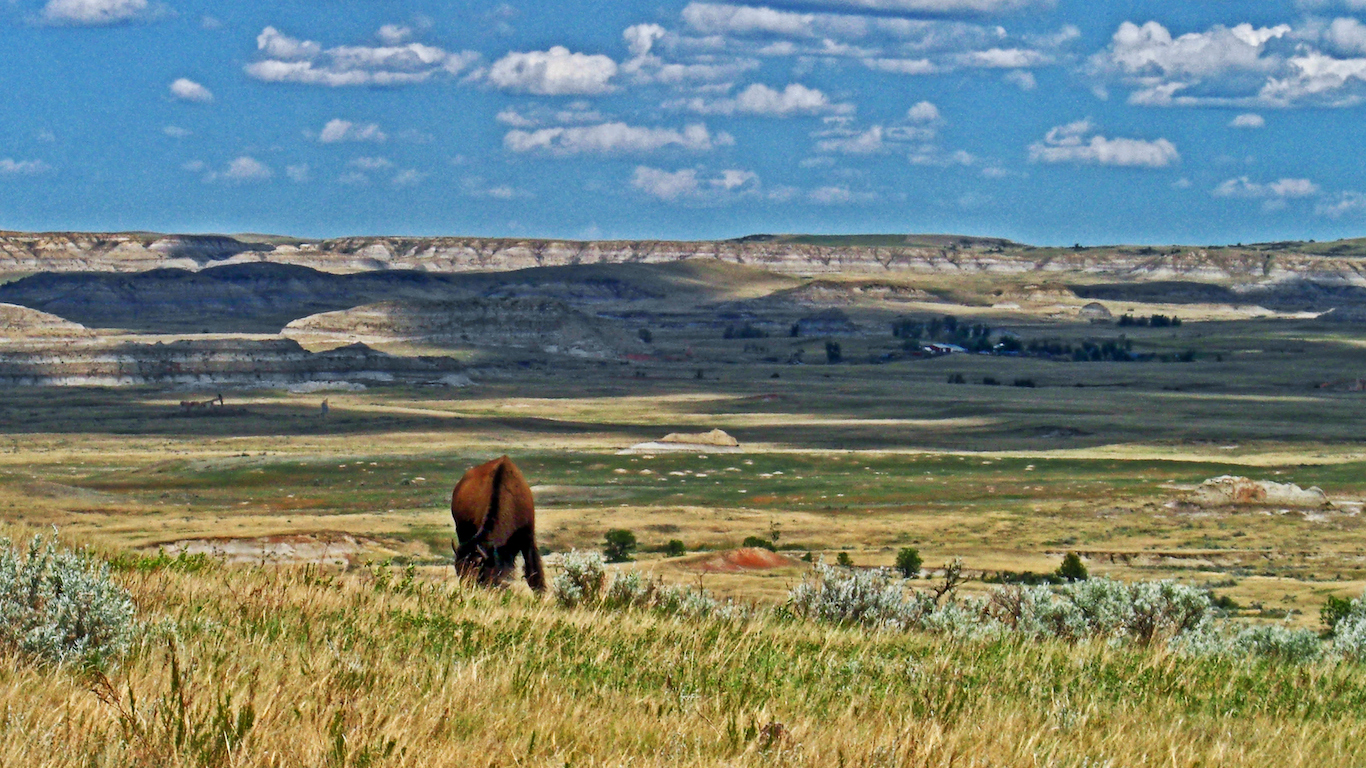
34. North Dakota
> Park: Theodore Roosevelt National Park
> 2016 visits: 753,880
> 5-year change in visits: +0.3%
> 2016 visitor spending (in thousands): $47,793.70
The Theodore Roosevelt National Park in North Dakota is named after the nation’s 26th president and one of its greatest conservationists. Roosevelt gained his appreciation for the West during his visit to the rugged terrain of the Dakota Territory while hunting bison in 1883.
[in-text-ad-2]

35. Ohio
> Park: Cuyahoga Valley National Park
> 2016 visits: 2,423,390
> 5-year change in visits: +0.1%
> 2016 visitor spending (in thousands): $69,728.20
The Cuyahoga Valley National Park, which became a national park in 2000, features rugged gorges, tree-lined hills, and marshes. Also in the nearly 33,000-acre park is a trail that follows the route of the historic Ohio & Erie Canal, which linked the Midwest to the burgeoning markets in the east. The park also contains the Canal Exploration Center, which details the importance of the canal system to the nation’s economy in the 19th century.

36. Oklahoma
> Park: Chickasaw National Recreation Area
> 2016 visits: 1,676,421
> 5-year change in visits: +0.4%
> 2016 visitor spending (in thousands): $26,493.90
Chickasaw National Recreation Area is a small-scale version of what is left of Platt National Park. While the surrounding area of the former park is now a part of Platt Historic District, Chickasaw remains preserved. The park is named after the Chickasaw Nation, who sold the land to the U.S. government in 1902, five years before Oklahoma became a state.
[in-text-ad]

37. Oregon
> Park: Crater Lake National Park
> 2016 visits: 756,344
> 5-year change in visits: +0.8%
> 2016 visitor spending (in thousands): $65,300.70
Crater Lake National Park was one of the earliest national parks in the United States, created in 1902. The crater was formed from a volcanic eruption 7,700 years ago. The park claims that its water is the purest in the world.
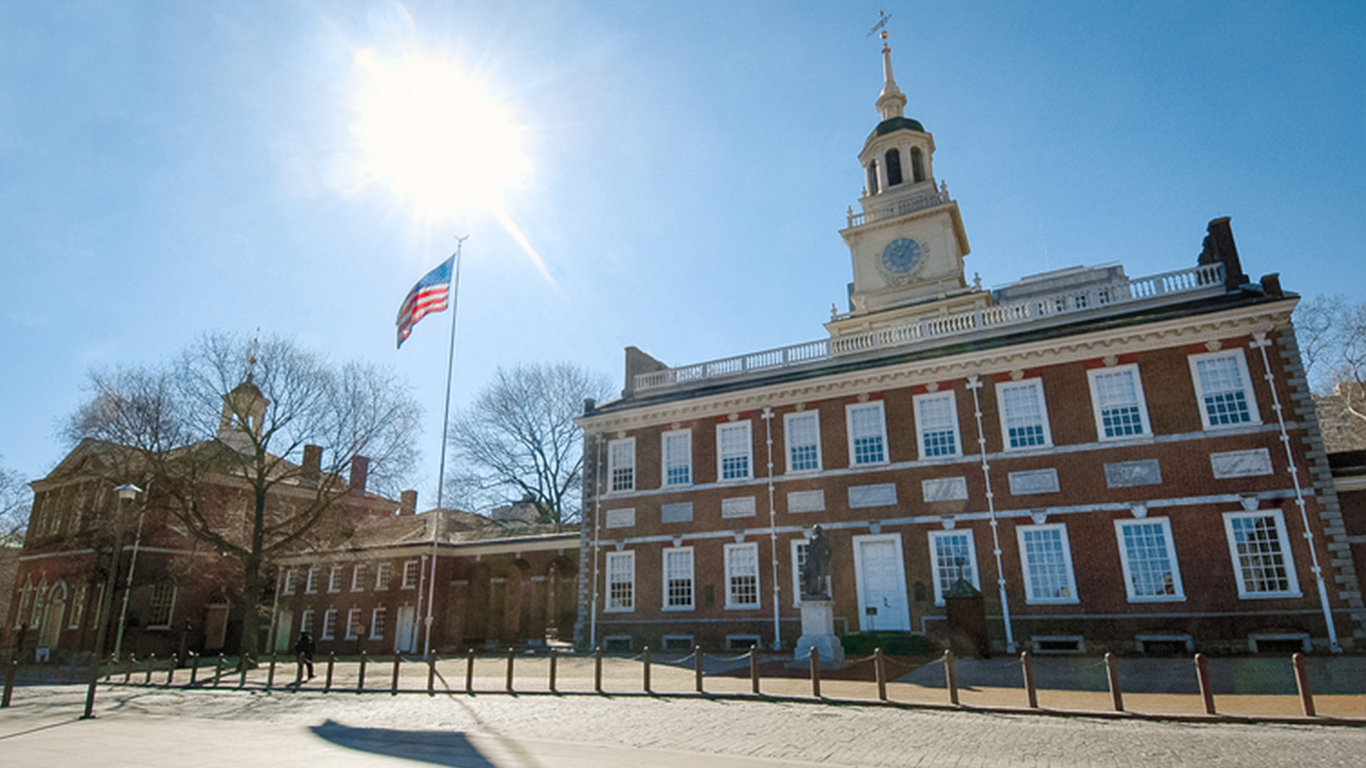
38. Pennsylvania
> Park: Independence National Historical Park
> 2016 visits: 5,067,510
> 5-year change in visits: +0.4%
> 2016 visitor spending (in thousands): $296,290.00
Some of the most important moments in the creation of the country happened at this national historical park. Visitors come to this UNESCO World Heritage Site to see where the Declaration of Independence and U.S. Constitution were debated and adopted, as well as to see the iconic Liberty Bell.
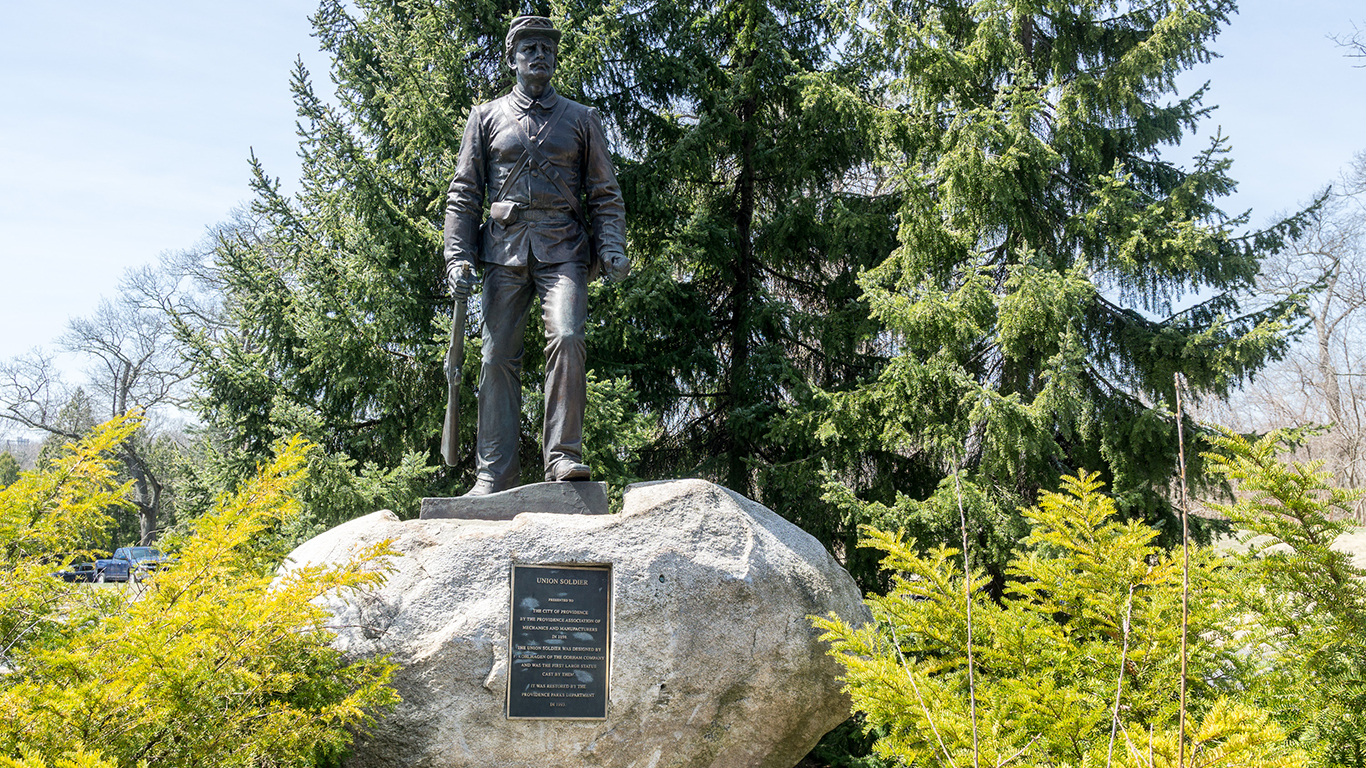
39. Rhode Island
> Park: Roger Williams National Memorial
> 2016 visits: 65,588
> 5-year change in visits: +0.3%
> 2016 visitor spending (in thousands): $3,834.80
Roger Williams National Memorial pays homage to the advocate of religious freedom. The Hahn Memorial in the park is dedicated to Isaac Hahn, the first person of the Jewish faith to be elected to public office from Providence. Also, one of the two interpretative gardens is dedicated to Native Americans and the other depicts a colonial kitchen garden.
[in-text-ad-2]
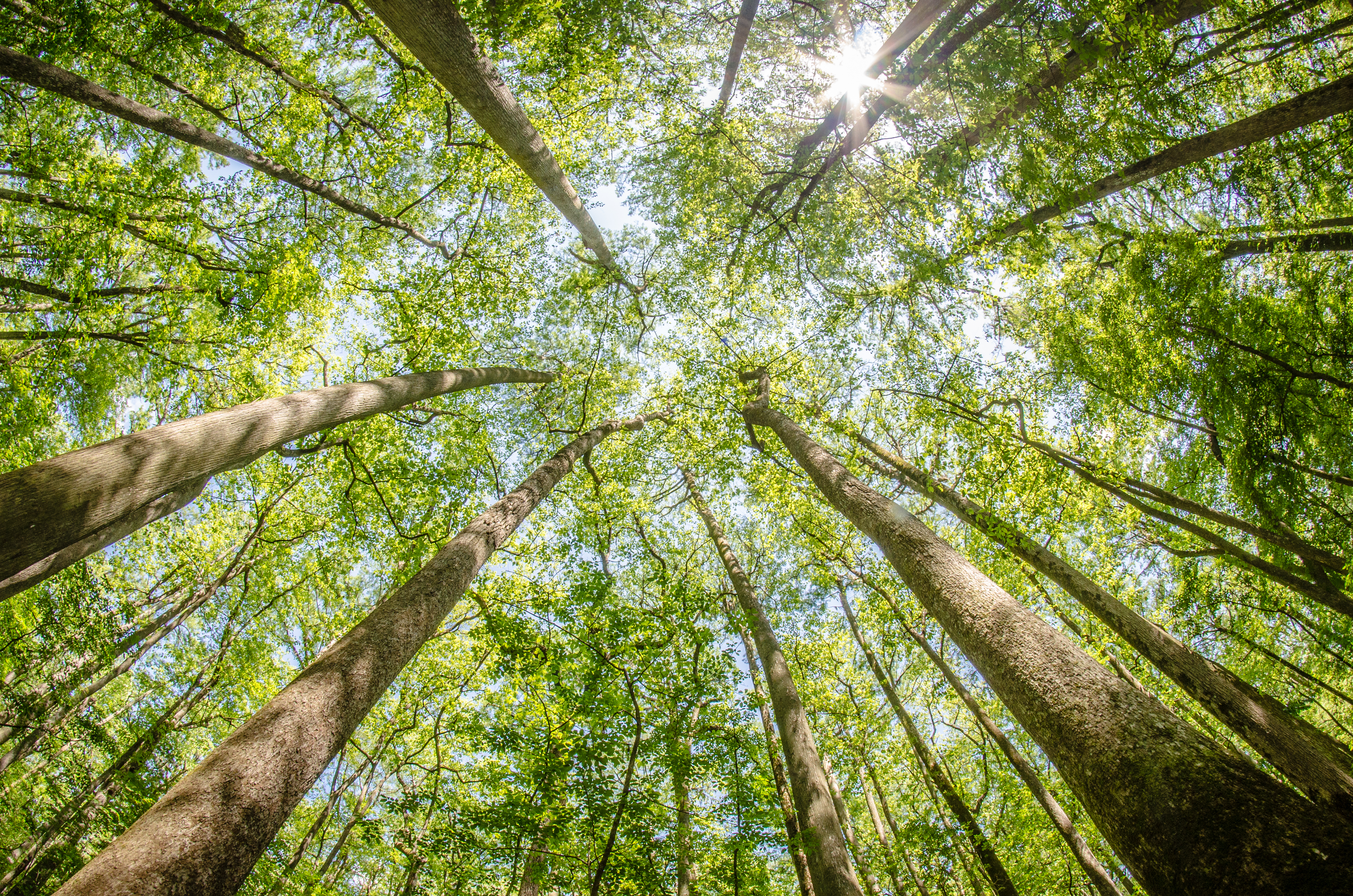
40. South Carolina
> Park: Congaree National Park
> 2016 visits: 143,843
> 5-year change in visits: +0.2%
> 2016 visitor spending (in thousands): $7,307.30
One of the newest parks in the National Park Service, Congaree received its designation as a national park in 2003 after years of campaigning. Once there, visitors can go on an owl prowl, a nighttime trek where the eerie calls of owls are heard. The park is named after the Congaree Native American tribe that once lived in the area before European settlers.
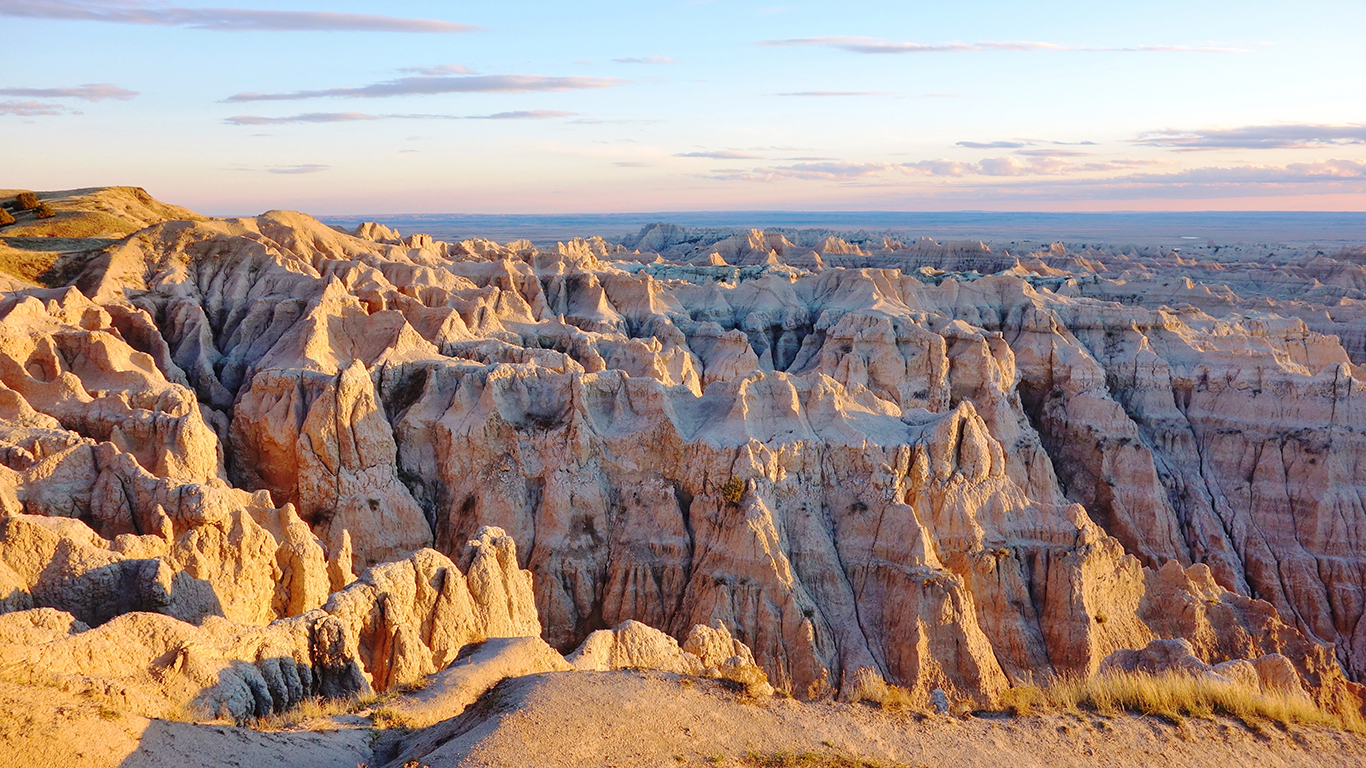
41. South Dakota
> Park: Badlands National Park
> 2016 visits: 996,263
> 5-year change in visits: +0.1%
> 2016 visitor spending (in thousands): $63,746.60
Badlands National Park, established in 1939, contains some of the richest fossil finds in the world. Ancient mammals such as rhinos, horses, and saber-toothed cats once roamed the craggy expanse of 244,000 acres. Today, the park is home to bison, bighorn sheep, prairie dogs, and black-footed ferrets.
[in-text-ad]

42. Tennessee
> Park: Great Smoky Mountains National Park
> 2016 visits: 6,335,160
> 5-year change in visits: -0.3%
> 2016 visitor spending (in thousands): $942,731.80
Shared equally between Tennessee and North Carolina, Great Smoky Mountains National Park also has a long human history spanning thousands of years.From prehistoric Paleo Indians to loggers in the 1800s, the park remains preserved to maintain the artifacts and stories of the people who have lived in the area.

43. Texas
> Park: Big Bend National Park
> 2016 visits: 388,290
> 5-year change in visits: +0.1%
> 2016 visitor spending (in thousands): $34,197.40
With a mix of a mix of desert, mountain, and river scenery, the Big Bend National Park is named for the curve of the Rio Grande in southwest Texas. Some of the archeological sites in the park date back 10,000 years. Among the features in the 800,000-acre park are sea fossils, dinosaur bones, and volcanic dikes. Big Bend is one of the remotest of all U.S. national parks — the closest major city is El Paso, 300 miles west. Even so, park attendance has been rising.
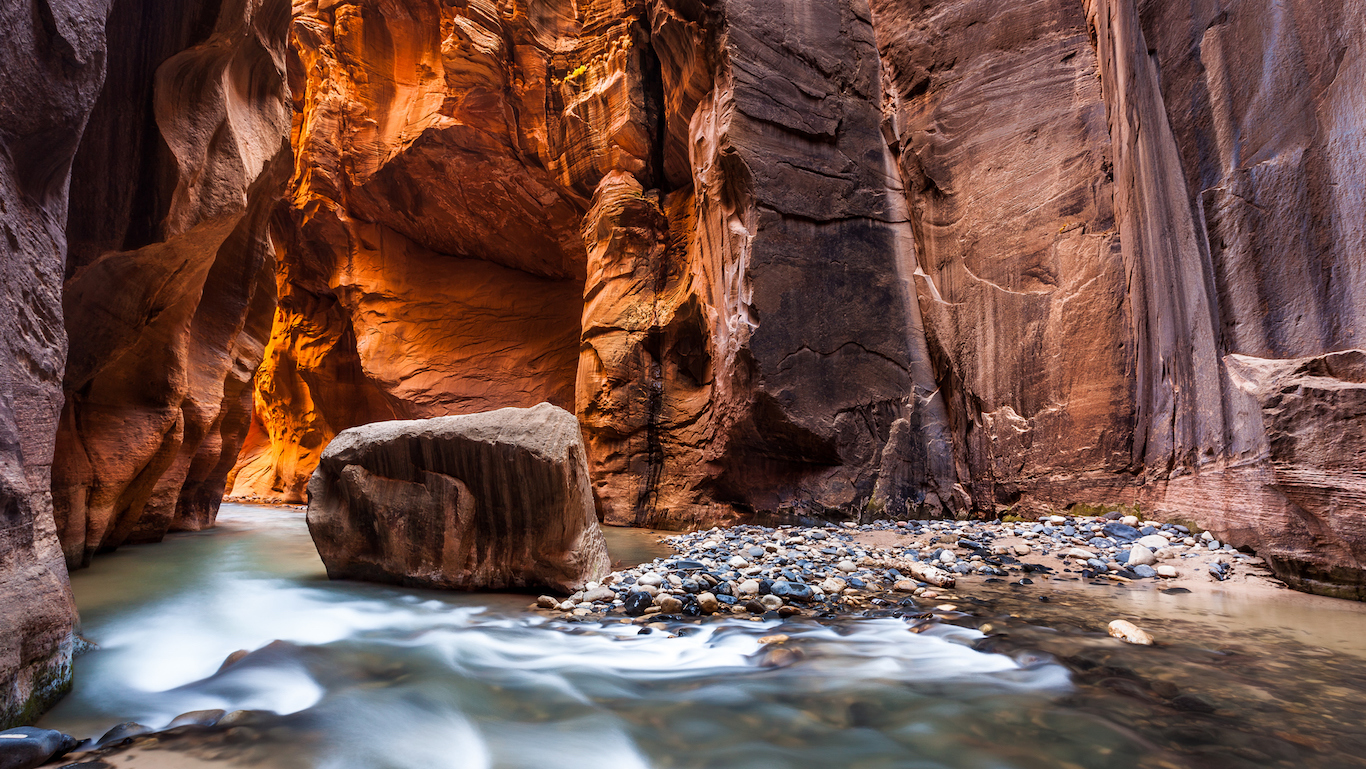
44. Utah
> Park: Zion National Park
> 2016 visits: 4,295,127
> 5-year change in visits: +0.5%
> 2016 visitor spending (in thousands): $244,531.70
Zion National Park, federally designated in 1919, is one of the most visited national parks in the country. It is also the first national park of Utah. Its cliff formations are estimated to be around 150 million years old.
[in-text-ad-2]
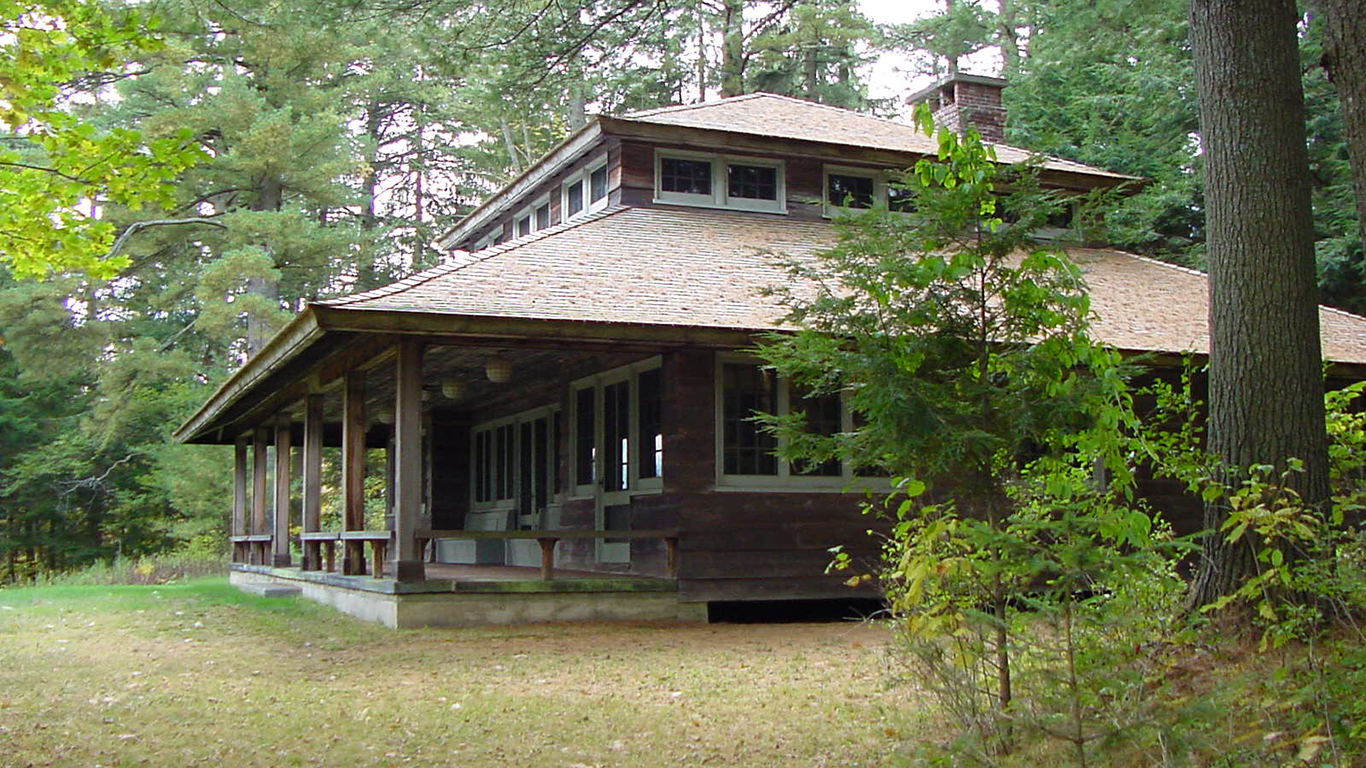
45. Vermont
> Park: Marsh-Billings-Rockefeller National Historical Park
> 2016 visits: 55,716
> 5-year change in visits: +0.9%
> 2016 visitor spending (in thousands): $3,257.60
Marsh-Billings-Rockefeller National Historical Park is Vermont’s first national park, opening in June of 1998. The park preserves the site where early conservationist Frederick Billings created a managed forest and a dairy farm. The park is focused on conservation history and the nature of land stewardship in the United States. The park is named after global environmental thinker George Perkins Marsh, Billings, and members of the Rockefeller family.

46. Virginia
> Park: Colonial National Historical Park
> 2016 visits: 3,352,656
> 5-year change in visits: 0.0%
> 2016 visitor spending (in thousands): $196,024.90
Virginia’s most visited park tells the story of the colonization of America. Visitors to Colonial National Historical Park can tour historic Jamestowne — the first permanent English settlement in North America dating back to 1607 — and the last major battle of the Revolutionary War at Yorktown.
[in-text-ad]
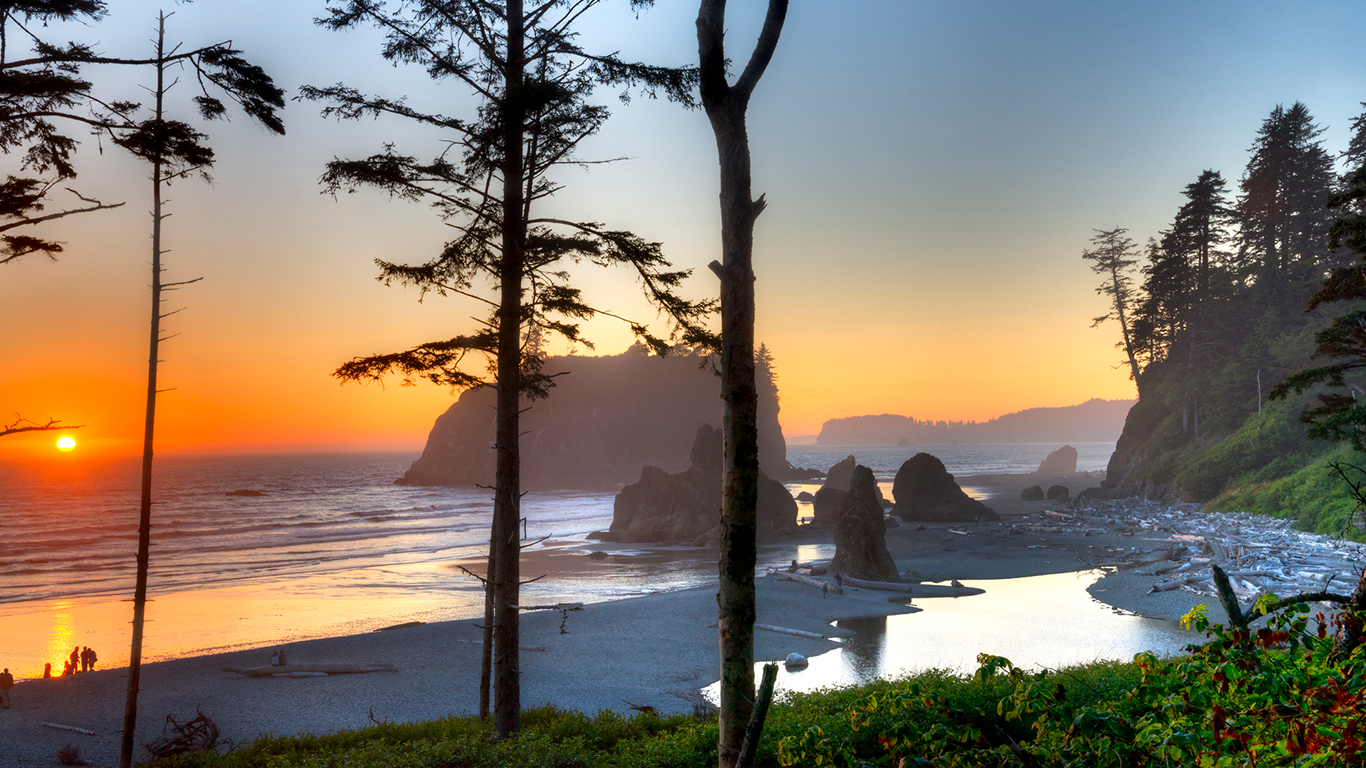
47. Washington
> Park: Olympic National Park
> 2016 visits: 3,390,221
> 5-year change in visits: +0.1%
> 2016 visitor spending (in thousands): $286,786.30
Olympic National Park in Washington spans nearly 1 million acres. The park was established in 1938 and offers a variety of natural experiences for visitors such as glacier-capped mountains, temperate rain forests, and 70 miles of coastline.

48. West Virginia
> Park: Harpers Ferry National Historical Park
> 2016 visits: 335,691
> 5-year change in visits: +0.3%
> 2016 visitor spending (in thousands): $16,577.20
Harpers Ferry National Historical Park marks several significant events in American history. It was here where John Brown’s abolitionist uprising against slavery ended. Harpers Ferry was also the spot of the largest surrender of Union troops during the Civil War. It was also the site of one of the first integrated schools in the United States..

49. Wisconsin
> Park: Saint Croix National Scenic River
> 2016 visits: 354,129
> 5-year change in visits: +0.3%
> 2016 visitor spending (in thousands): $30,333.20
The St. Croix and Namekagon rivers combine to form the St. Croix National Scenic Riverway, offering more than 200 miles of water coursing through forested landscape. The first European visitors to the region were French fur traders who came to the St. Croix valley in the late 1600s and began interacting with the Dakota and Ojibwe tribes.
[in-text-ad-2]
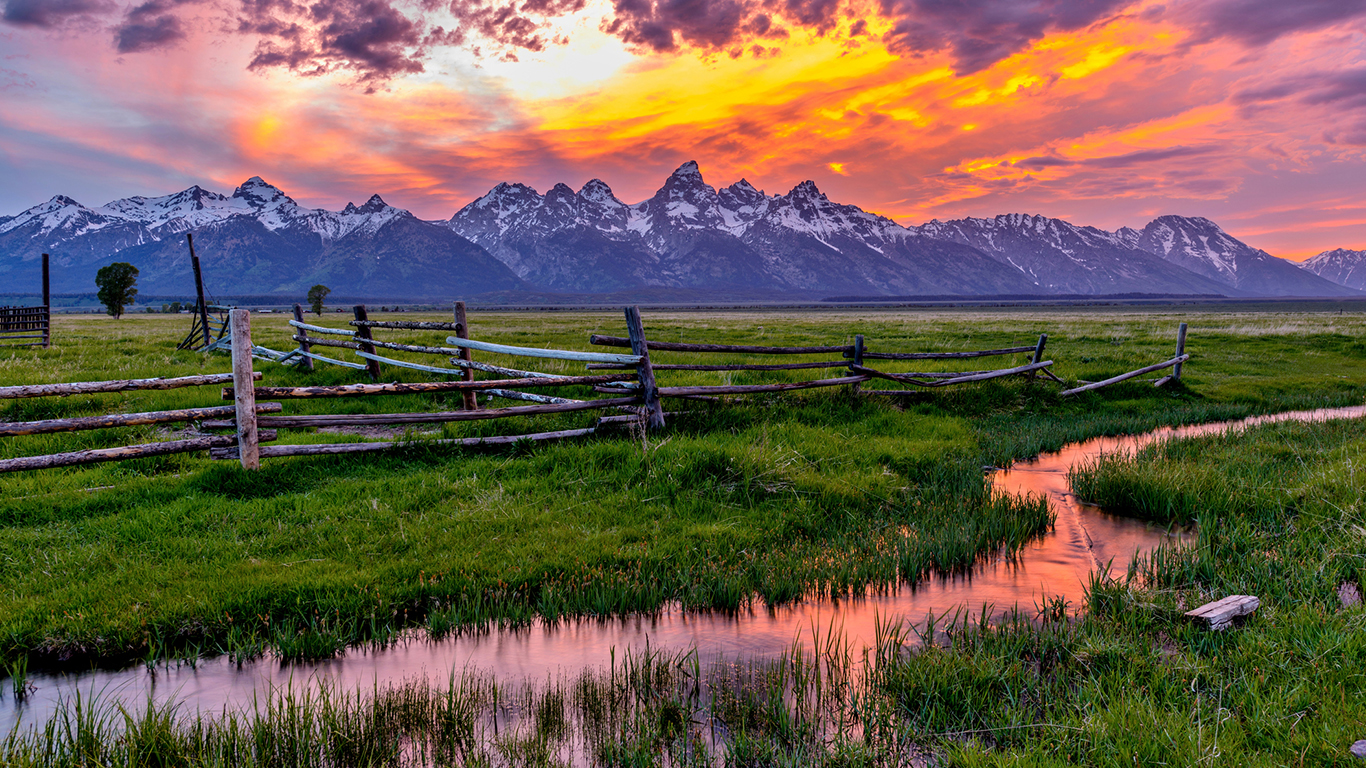
50. Wyoming
> Park: Grand Teton National Park
> 2016 visits: 3,270,076
> 5-year change in visits: +0.3%
> 2016 visitor spending (in thousands): $597,290.50
There are few more breathtaking vistas than those at Grand Teton National Park. Those include views of verdant valley floors, mountain meadows, alpine lakes, and the soaring peaks of the Teton Range. Grand Teton National Park took decades to establish before Congress combined the original park, the national monument, and lands donated by philanthropist John D. Rockefeller, Jr. to establish present-day Grand Teton National Park in 1950.
Methodology
To identify the most visited national parks in each state, 24/7 Wall St. reviewed recreational visits in the 2006-2016 annual visitation report from the National Park Service (NPS). The NPS aggregates visitation data for various different government land designations and visitation purposes. For the most part, only National Parks (NP) and National Historical Parks (NHP) were considered in our analysis. For states that do not have an NP or NHP, other designations were used in their place.
After two decades of reviewing financial products I haven’t seen anything like this. Credit card companies are at war, handing out free rewards and benefits to win the best customers.
A good cash back card can be worth thousands of dollars a year in free money, not to mention other perks like travel, insurance, and access to fancy lounges.
Our top pick today pays up to 5% cash back, a $200 bonus on top, and $0 annual fee. Click here to apply before they stop offering rewards this generous.
Flywheel Publishing has partnered with CardRatings for our coverage of credit card products. Flywheel Publishing and CardRatings may receive a commission from card issuers.
Thank you for reading! Have some feedback for us?
Contact the 24/7 Wall St. editorial team.